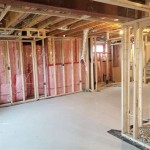Building a Basement Under an Existing House
Adding a basement to an existing house can be a transformative renovation that adds valuable square footage, increases the home's value, and creates new possibilities for living and storage. However, it is also a complex and challenging project that requires careful planning, expert execution, and a substantial financial investment.
Challenges of Basement Construction under an Existing House
- Excavation: Digging a basement under an existing foundation requires precise excavation without compromising the structural integrity of the house above.
- Waterproofing: Proper waterproofing measures are essential to prevent water seepage and flooding in the new basement.
- Structural Reinforcement: The foundation and walls of the existing house may need to be reinforced to accommodate the additional weight of the basement.
- Access: Creating an access point to the basement, such as a staircase or elevator, can be a complex task, especially in older homes.
Steps Involved in Building a Basement Under an Existing House
1. Planning and Design
The first step is to consult with an experienced architect and structural engineer to design the basement and assess its feasibility. They will determine the optimal size, shape, and depth of the basement, as well as any necessary structural modifications.
2. Excavation
Once the plans are finalized, excavation can begin. This involves carefully digging out the soil under the house, ensuring that the existing foundation and walls are not damaged. Shoring or underpinning may be necessary to support the house during this process.
3. Waterproofing
Thorough waterproofing is crucial to protect the new basement from water damage. This involves installing a waterproof membrane, drainage systems, and sump pumps to prevent moisture penetration.
4. Foundation and Walls
The foundation and walls of the basement are then constructed. These are typically made of poured concrete or concrete block and must be strong enough to support the weight of the house above.
5. Access
An access point to the basement is created, either through a staircase or elevator. The staircase must be designed to meet building codes and provide safe and convenient access.
6. Utilities and Finishing
Finally, the basement is outfitted with utilities, such as lighting, plumbing, and HVAC. Once the utilities are installed, the basement can be finished to create a living space, storage area, or any other desired use.
Benefits of Adding a Basement Under an Existing House
- Increased Square Footage: A basement adds valuable square footage to the home, providing additional space for bedrooms, bathrooms, entertainment areas, or storage.
- Increased Home Value: A finished basement can significantly increase the overall value of the home.
- Improved Energy Efficiency: A basement can insulate the foundation and walls of the house, reducing energy consumption and lowering heating and cooling costs.
- Enhanced Flexibility: The basement can be customized to meet the specific needs and preferences of the homeowners.
Considerations before Building a Basement
- Cost: Building a basement under an existing house is a significant investment, and the cost can vary widely depending on the size, complexity, and materials used.
- Time: The construction process can be lengthy and disruptive, potentially affecting the occupants of the house.
- Permits and Inspections: Obtaining the necessary permits and passing inspections is essential to ensure compliance with building codes and safety standards.
- Impact on the Existing House: The construction process can place stress on the existing foundation and structure, so it is crucial to have a thorough assessment conducted before proceeding.
- Professional Expertise: Building a basement under an existing house requires specialized knowledge and experience. It is highly recommended to hire qualified contractors and consult with experts throughout the process.
Adding a basement to an existing house can be a transformative and rewarding project. However, it is a complex endeavor that requires careful planning, meticulous execution, and the involvement of experienced professionals to ensure a successful and safe outcome.

How To Build A Basement Under House Knowles

Build A Basement Under An Existing House What You Need To Know

Digging Basements Repairing Foundations Lifting Homes

How To Build A Basement Under An Existing House Property London

Can You Build A Basement Under An Existing House Basementing Com

Can You Add A Basement To An Existing House

Maximize Living Space With Basement Excavation Serbu Sand Gravel

Can You Add A Basement To An Existing House

Digging Basements Repairing Foundations Lifting Homes

How To Create A New Basement Homebuilding
See Also








